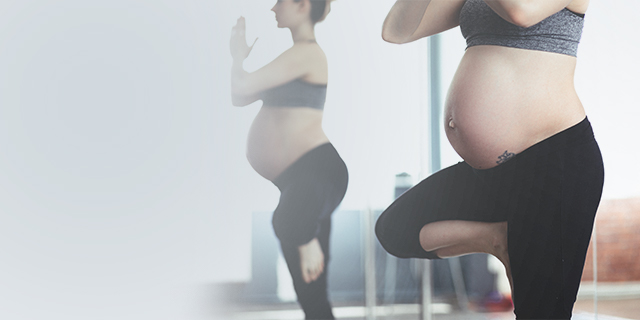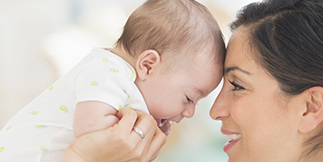Pregnancy used to be seen as a time when women should rest and take life relatively easy. This was based on concerns about possible negative effects on the baby and mothers overexerting themselves. But now we know that regular and moderate exercise over the term of a normal pregnancy, is not only beneficial for mothers but for their babies as well.
The attitude that pregnancy somehow made women more fragile was a commonly held belief in the past, though this holds no basis in fact. Pregnancy is not an illness or a disability and the majority of healthy women proceed to deliver their babies at term without any problems.
The general rule is that if you have already been exercising before you conceived, then it is likely to be safe for you to continue for the first trimester of your pregnancy at least.
It makes good general sense to check with your midwife or doctor to see if it’s safe for you to continue exercising, or start a new pregnancy exercise programme.
How does the baby hold on?
Many mothers worry that exercising may have a negative impact on how securely their baby stays attached to the uterine wall. Visions of their baby holding tightly onto the umbilical cord are enough to scare even the most relaxed mother. However, there is no evidence to support this concern. Babies are designed to ensure their survival and only in abnormal and extreme circumstances is exercise likely to cause problems leading to miscarriage. The unfortunate truth is that if a mother is going to miscarry, it will happen anyway, no matter how much exercise she does.
What if I don’t normally do any exercise?
It is generally not recommended to start an exercise programme or a regular sport in the first trimester of pregnancy. Stressing your body beyond its normal functioning may in turn stress your baby. If you are keen to start an exercise programme, check with your midwife or obstetrician first.
The key is to build up your exercise routine gradually so that over time, your tolerance and ability improves. Be sensitive to the signals your body is giving you and stop if you feel you are at risk of going too hard. Don’t expect to launch into a programme that will bring amazing results. Pregnancy is not a time to restrict your diet or try to lose weight through a rigorous exercise regime!
One purpose of exercising during pregnancy is to avoid gaining too much weight and in turn, to reduce the increased health risks associated with this. It is also about improving your body’s strength and your individual stamina.
Benefits of pregnancy exercise for mothers:
Core strengthening exercises will help reduce the likelihood of injury to the pelvic joints, ligaments and muscles, which get relaxed by pregnancy hormones
Helps you maintain a healthy weight gain
Helps you to feel energised, reduce stress, stabilise your mood and improves your sleep
Helps to reduce the risk of developing gestational diabetes
Pregnant women who exercise have shorter labours and are less likely to need interventions
Helps to reduce back pain and strain
Helps to prevent and relieve constipation
Builds stamina and increases fitness
Helps to condition the muscles that are necessary to maintain your balance – as your pregnancy continues, these muscles will play an important role in helping to maintain your stability and prevent you from falling
Helps you approach your labour with a positive “can do” attitude; women who are in tune with their bodies, who know how they work and are used to placing some (reasonable) physical demands on themselves, tend to cope better at times of stress
Helps with postpartum recovery and return to pre-pregnancy weight range
Pelvic floor exercises are beneficial in reducing the likelihood of delivery complications; they also reduce the risk of uterine and bladder prolapse
Doing group exercise with other pregnant mothers can help with developing support networks and friendships; if these relationships are maintained, there is a potential for reducing the chances of isolation and for mothers becoming depressed following delivery
Benefits of pregnancy exercise for babies:
Improved oxygenation and blood flow via the placenta to the baby
Healthier weight range at birth; because there is less likelihood of mothers developing gestational diabetes, babies benefit as well
When shouldn’t I exercise during my pregnancy?
If you experience vaginal bleeding, contractions, your membranes have ruptured or you are showing signs that your labour may have started
If you experience breathlessness, become increasingly short of breath, develop any chest pain or a headache, you need to immediately stop exercising and see your doctor for an assessment
If you see bright dots before your eyes, or develop a sharp pain similar to indigestion, you need to see your doctor immediately
If you have a headache, your blood pressure is elevated; you have generalised swelling or have been diagnosed with preeclampsia
If you have heart disease or problems with your blood pressure being too low or high
If your baby is not growing as well as it should be or if growth is retarded
If you are not gaining an adequate amount of weight through your pregnancy and have been advised to restrict your exercise and conserve energy
If you feel faint, lightheaded or generally unwell
If your baby is not as active as it has been or you are worried about its movements
If you commence having uterine contractions (contractions of your womb), particularly before your baby is due – exercising can increase the risk of pre-term labour in high-risk pregnancies
What exercises to avoid during your pregnancy:
Exercise that could potentially strain or stretch your ligaments. The hormone relaxin works beautifully on relaxing the pelvic ligaments, but sometimes it works too well. Lifting weights can be risky, particularly past the second trimester. Likewise, any general heavy lifting needs to be avoided if possible.
Jogging or running – the constant jarring nature will do your pelvic floor no favours, not to mention your breasts or your knees; consider going for a brisk walk instead.
Horse riding, skiing, squash or vigorous ball and racket sports, gymnastics and ice-skating can all be risky.
Contact sports such as football, netball and basketball can all pose problems as well, particularly in the third trimester when pregnancy changes the mother’s centre of balance and falling is more likely.
Sudden, intense and rigorous exercise programmes. The ideal way to go is to start slow and build up gradually. You are much better doing this and avoiding an injury which could mean you are immobile for weeks.
Exercises that feel like a chore. You will come to resent them, no matter how much you tell yourself they’re good for you. Aim to find something you like and that you’re more likely to keep up.
Any exercise that causes your body temperature to increase by more than 1 degree Celsius needs to be avoided; it can lead to overheating or dehydration.
Types of pregnancy exercise
The best type of exercise is one that you will enjoy and are likely to continue. An initial burst of enthusiasm can soon wane, so think about what exercise appeals to you and what will be sustainable in the long term.
Apply the SMART principle to your exercise goal setting. Be Specific about what you want to achieve, have Measureable goals, ones that are Achievable, are Result-oriented and Timely. Remember to squeeze an F in there too for Fun.
Look for exercise options that are opportunistic and not always formal or planned. Taking the stairs instead of the lift, walking the extra distance from a further bus or train stop, or volunteering to fetch something are all good ways of adding to the total number of hours you spend moving your body every day.
Current research has found that we are all better off having small, frequent bursts of activity and muscle contractions throughout the day, rather than one concentrated investment at a time. The frequency and length of time we spend moving is cumulative throughout the day.
Bodies with muscles, bone and ligaments are designed to move, whether pregnant or not. A sedentary lifestyle comes with a much greater risk of health problems and you will not be immune to these just because you are pregnant.
Aerobic Exercise
Any exercise that overloads the heart and lungs and makes them work harder is classified as aerobic exercise. Generally, aerobic exercise uses large muscle groups in the body.
Walking quickly, riding a bike, swimming and stair climbing are all great examples of aerobic exercises recommended during pregnancy.
Going for walks involving some hills and inclines will provide your muscles with ideal aerobic exercise. This will help your heart to work more effectively to pump blood around your body, through the placenta to your baby. The heart is like any other muscle in the body. The more effectively it works, the better it can do the job it is made for.
Bike riding is another good form of aerobic exercise. Most women find they can still manage to ride until they are into their third trimester. Of course, riding triathlons or mountain biking may be considered a little too risky. You may find it more comfortable to sit on a bike with a gel seat or a well-designed female seat.
Swimming offers one of the best forms of antenatal exercise – it helps build your stamina and muscle strength. The buoyancy of the water will also help to support your big tummy towards the end of your pregnancy. You can continue swimming until you go into labour and in fact, some women choose to birth their baby underwater.
A water aerobics class for pregnant women is a good way to stay fit and network with other women in the same condition. It is also good for women who may otherwise feel a little self-conscious of their size and wearing a swimsuit.
Anaerobic exercise
Exercise that is based on resistance and uses the energy within tissues and muscles, rather than the oxygen you will be breathing in. Generally, anaerobic exercises the muscles and improves a person’s flexibility.
Yoga, gentle weight training, Pilates and strength training are all useful during pregnancy. Yoga is seen as the perfect antenatal exercise for most women. It helps to build flexibility and gives a sense of inner calm. It is also a great form of exercise for couples to do together and helps with bonding between parents and their unborn baby.
Stretches that involve the arms and legs, back and spine, trunk and neck. Any type of exercise that involves stretching movements, gentle weight bearing or which improves your flexibility will be ideal.
Pelvic floor exercises, also known as Kegel’s exercises. It is important to start doing these from the start of pregnancy, if not before. The pelvic floor is like a trampoline or sling that supports your pelvic organs. If it is strong, it is more likely to hold these organs in their correct places. It is much easier to maintain a strong pelvic floor than try to rebuild it once it is weakened. Practice some Kegel’s every day and incorporate them into your daily activities.
Things to remember
Wear a supportive, firm bra to stop your breasts from bouncing and excess strain. Some women wear two bras when they are jogging and claim this reduces any discomfort.
Wear cool, comfortable clothing that is designed to stretch and move with you. Cotton, bamboo and hemp fibres are more absorbent and don’t restrict air flow.
Invest in a good pair of sports shoes. Your feet are affected by the hormone relaxin as well when you are pregnant. You may find you go up a shoe size or one foot becomes larger than the other by the end of your third trimester.
Try for 30-60 minutes of enjoyable, fun exercise every day.
Avoid exercising when the weather is very hot or humid, or within steam rooms or saunas.
By the third trimester of pregnancy, no more than 3 sessions of exercise a week are recommended.
Avoid becoming over-fatigued and exhausted. Your body is working very hard to grow and support your baby. All the energy you have needs to be divided between your normal every day metabolism, your daily activities and your pregnancy.
If you keep exercise fun, you’ll be more likely to maintain it. Arrange to go to a class with a friend, your partner or your older children. See opportunities to move and maintain some form of physical activity in a positive light.
Avoid exercises that require you to stand still for long periods of time while you wait your turn. This leads to pooling of blood in the lower limbs and swelling.
Trust your body if it’s telling you to slow down. You are the best judge of your own limits and tolerance. Slow down when you need to and have a rest.
If your midwife or doctor tells you to stop exercising, heed their advice!





















